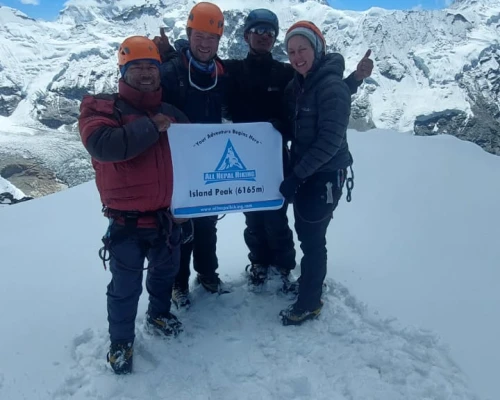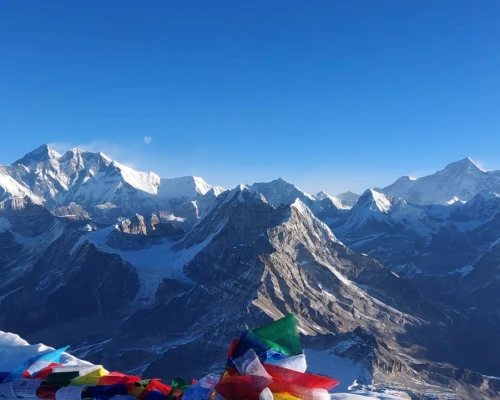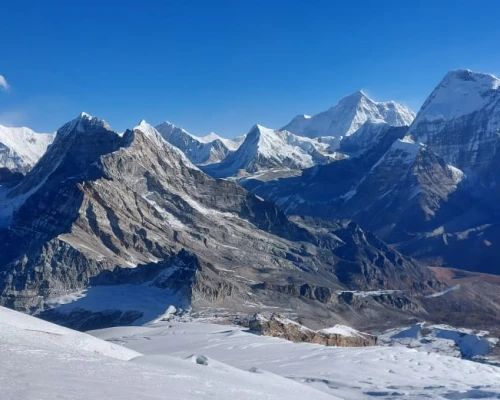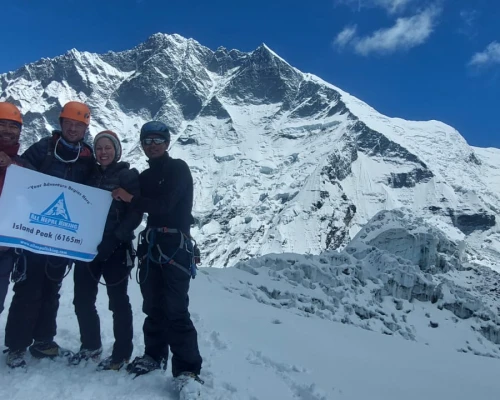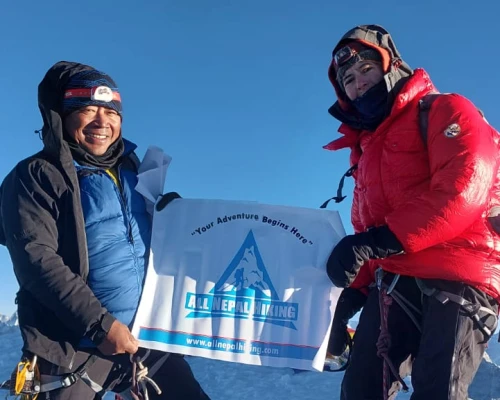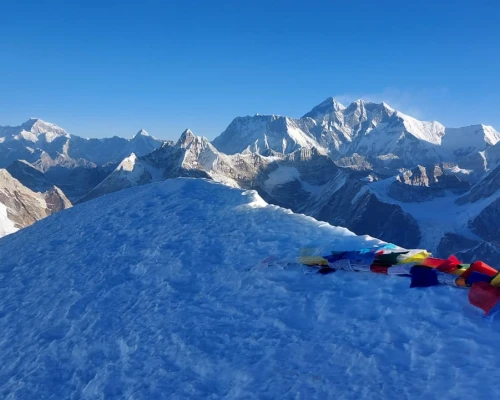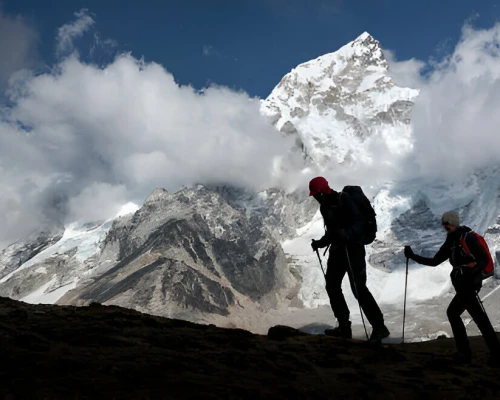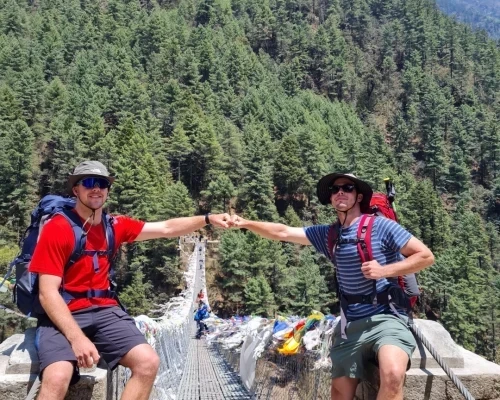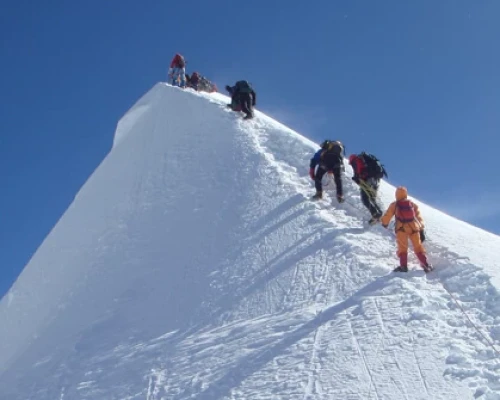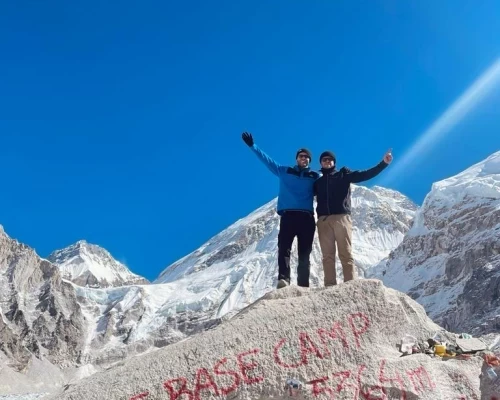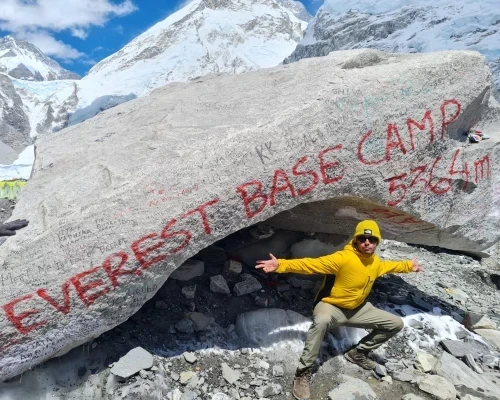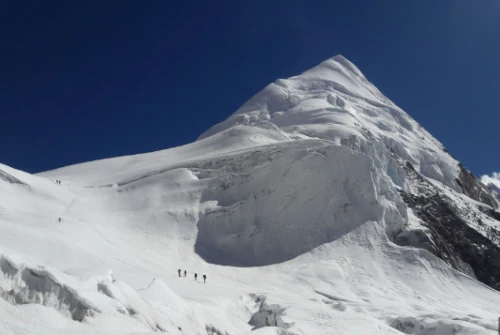The Island Peak Climbing with Everest Base Camp Trek is a thrilling 16-day Himalayan adventure that combines one of the world’s most iconic treks with an exhilarating alpine climb. Perfect for trekkers seeking to transition into mountaineering, this route allows us to experience both the soul-stirring beauty of the Khumbu region and the technical challenge of summiting Island Peak (6,189m). The journey takes us through ancient Sherpa villages, high-altitude passes, dramatic glaciers, and the base of Mount Everest itself, culminating with a guided climb to a majestic Himalayan summit.
Overview of Island Peak Climbing with EBC Trek
The Island Peak Expedition with EBC Trek is a perfectly designed adventure that combines the spiritual richness of trekking to Everest Base Camp with the technical thrill of summiting a Himalayan peak. Over 16 days, we explore the Khumbu and Chhukung valleys, traverse high mountain passes, and climb above 6,000 meters into the thin air of the Khumbu region. This trek offers more than just natural beauty; it provides a cultural deep dive into the Sherpa heartland. As we pass through ancient villages like Namche Bazaar, Pangboche, and Tengboche, we are immersed in traditions, chortens, prayer flags, and monastic rituals that have stood the test of time.
Beyond Everest Base Camp, the trail continues east into the lesser-traveled Imja Valley, leading us to Island Peak Base Camp a dramatic, glacier-ringed site beneath towering ice walls. Our summit day on Island Peak (6,189m) is both physically demanding and incredibly rewarding, requiring alpine skills like rope climbing, use of crampons, and ice axe techniques. The climb is considered one of the most achievable trekking peaks in Nepal, ideal for adventurers seeking to step beyond basic trekking into the world of mountaineering. With our expert guides, fixed ropes, and proper acclimatization, the summit becomes a safe and exhilarating reality.
Throughout the trek, we are surrounded by awe-inspiring Himalayan giants, 8000-meter Everest, Lhotse, Nuptse, Ama Dablam, Makalu, and traverse glacial moraines, hanging bridges, and alpine ridgelines. This adventure is not only about ticking off iconic destinations but also about transformation. We return stronger, more connected with nature, and deeply enriched by the culture, landscapes, and personal triumphs achieved step by step in the Himalayas.

Why Should You Do This Trek?
Few treks in the world offer the diversity, challenge, and reward of the EBC with Island Peak Expedition Trek. First, you get to stand at Everest Base Camp, a dream for many trekkers, and climb a 6,000-meter peak in one seamless itinerary. The blend of natural grandeur, from thick forests to barren glaciers, along with deep cultural exposure to Sherpa heritage, makes this more than just a physical journey’s a life-changing experience.
Moreover, the sense of accomplishment that comes with summiting Island Peak, seeing Everest at sunrise from Kala Patthar, and walking in the footsteps of legends is unparalleled. Whether you're training for bigger climbs or seeking a personal transformation, this trek delivers adventure, insight, and a powerful connection to the Himalayas.
Which is the Best Time for this Trek?
The best time to undertake the Island Peak Climbing with EBC Trek is during the pre-monsoon (Spring: March to May) and post-monsoon (Autumn: September to November) seasons. Trekking in Spring, the trails are vibrant with blooming rhododendrons, the skies are generally clear, and the temperatures are moderate, ideal for both trekking and climbing. During Autumn trekking in Nepal, the monsoon rains have washed the dust from the air, resulting in crisp mountain views, dry trails, and stable climbing conditions.
These seasons offer the best mix of visibility, weather, and safety. Winter (December–February) brings extreme cold and snow, making Island Peak harder to access, while summer/monsoon (June–August) is prone to heavy rain and cloud cover, with a higher risk of flight cancellations to and from Lukla.
What Kind of Preparation is Required for Island Peak Expedition with EBC Trek?
Embarking on the Island Peak Expedition with Everest Base Camp Trek requires more than just enthusiasm it demands physical readiness, mental resilience, and logistical preparation. Physically, we should begin a training routine at least 8 to 12 weeks in advance. This can include cardio workouts like hiking, running, swimming, or cycling 4–5 times a week, combined with strength training, particularly for legs and core. Stair climbing with a loaded backpack is especially useful. High-altitude treks and day hikes are ideal for simulating trail conditions.
Equally important is mental preparation. Altitude sickness, fatigue, cold, and unpredictable weather are all real challenges. Maintaining a positive mindset and adaptability is key. It's also highly beneficial to educate ourselves on basic mountaineering skills, such as using crampons, harnesses, and ascenders, as these are essential during the Island Peak summit push. While technical experience is not mandatory, familiarity with rope techniques, glacier travel, and ice axe use will increase confidence and safety.
Logistically, we must ensure all personal gear is in order. A good-quality sleeping bag (-20°C rating), layered clothing, waterproof boots, and proper trekking poles are non-negotiables. Most climbing gear (crampons, harnesses, helmets, jumar, figure-8 descender) can be rented in Chhukung or Kathmandu. Travel insurance that covers high-altitude trekking and emergency evacuation is essential, and consulting a doctor for altitude medication (like Diamox) is highly recommended.

What Are the Accommodation Types During the Trek and Climb?
Accommodations during the Everest Base Camp trek vary depending on altitude and remoteness, but they are generally referred to as “teahouses” or mountain lodges in the Himalayas. In lower elevations such as Lukla, Namche Bazaar, and Tengboche, the teahouses are relatively comfortable with private twin rooms, communal dining areas, and even access to hot showers and Wi-Fi (for a fee). Rooms are simple but cozy, with basic beds, foam mattresses, and blankets.
As we move higher into the Khumbu, particularly in Lobuche, Gorak Shep, and Chhukung, accommodations become more rudimentary. Facilities are limited, insulation is poor, and hot showers may not be available. Rooms may be colder, but sleeping bags do the job. Toilets are generally shared and may be squat-style or dry toilets, depending on the lodge.
At Island Peak Base Camp, we stay in tented camps. These are well-organized expedition-style setups with two-person sleeping tents, a kitchen/dining tent, and a toilet tent. Foam mattresses and sleeping pads are provided, but we need to bring or rent our own high-quality sleeping bags. The base camp is rustic but secure and provides all the essentials for a safe and warm rest before and after the summit attempt.
What Kind of Food and Drinks Are Available During Peak Expedition ?
Food during the trek is surprisingly diverse, especially in villages up to Dingboche and Namche Bazaar. Every teahouse operates a kitchen offering a standard trekking menu. Common and recommended meals include Dal Bhat (rice, lentil soup, vegetables), which provides a great balance of energy and nutrients. Other popular dishes include fried rice, noodles, pasta, momo (dumplings), soups, pancakes, and eggs. In higher elevations, food options are simpler but still nourishing. Since meat is often carried for days on foot, we avoid meat above Namche Bazaar to prevent illness.
For breakfast, options include porridge, toast, chapati, muesli, and tea or coffee. Teahouses stock various snacks like chocolate bars, biscuits, and Pringles, although prices increase with altitude. In the early days of the trek, you’ll also find apple pie, bakeries, and even espresso in Namche Bazaar and Tengboche.
Drinking water is available throughout the trek, but we should always purify it using water purification tablets or a portable filter. Bottled water is available but discouraged due to plastic waste. Teahouses provide boiled drinking water for a small fee, which is the most eco-friendly and reliable method. Tea, ginger lemon honey, hot chocolate, and other warm drinks are also widely available to keep us hydrated and warm.
At Base Camp, meals are more expedition-style, typically rice, pasta, potatoes, soups, and hot drinks, prepared by the cook team. Hydration is crucial at altitude, and guides ensure we drink enough fluids during the climb.
Who Is This Trek Perfect For?
This trek is designed for experienced trekkers and physically fit adventurers who are looking to elevate their Himalayan experience by combining high-altitude trekking with a beginner-friendly climbing expedition. While Island Peak does not require prior mountaineering experience, it is highly recommended for those who have already completed a multi-day trek above 3,000 meters, such as the Annapurna Circuit, Everest Base Camp, or similar. The climb involves glacier travel, the use of fixed ropes, and basic ice climbing techniques. Therefore, individuals who are in good shape, mentally prepared for high altitude, and open to learning climbing skills will find this trek both accessible and immensely satisfying. It's also a fantastic stepping stone for those considering future climbs of more technical peaks like Mera Peak or even 7,000–8,000m expeditions.

